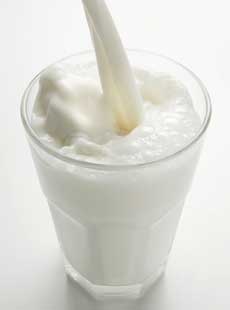The skinny on skim milk

 The perfect recovery drink comes from a cow
The perfect recovery drink comes from a cow
After a training run, many runners immediately reach for a bottle of energy drink or choose to fill up on a protein shake. But you don’t have to turn to magic powder concoctions in order to rehydrate and recover. In fact, there’s one beverage that’s often put on the backburner, but can efficiently help an athlete recover after exercise: skim milk.
Milk as part of an everyday diet
There are many myths surrounding skim and homogenized milk: does skim milk really have way more sugar than homogenized milk? Should we avoid homogenized milk because it has more fat? Is one variety of milk better for our health than others? Ashley Charlebois, a registered dietician from Fortius Sport & Health in Vancouver, explains that dairy can make up part of a healthy diet. “Milk is a great source of carbohydrates and protein, but it also meets an individual’s calcium and vitamin D needs.”
Regardless of whether milk is skimmed or homogenized or somewhere in between, the important vitamins and minerals are provided at essentially the same proportion. For example, the list of nutrient data compiled by Health Canada demonstrates that both skim and homogenized milk have 0.996 micrograms of vitamin D per 100 grams of milk. The amount of calcium is also comparable: skim milk contains 122 mg of calcium while homogenized milk has 113 mg of calcium. “While both varieties of milk provide essential vitamins and minerals,” Charlebois explains, “homogenized milk does have a higher saturated fat content.”
Skim milk as a recovery drink
Dr. Susan Barr, a food health and nutrition professor at the University of British Columbia, explains that “the nutrition guidelines for intake after training are to rehydrate, replenish carbohydrates (especially if another hard, glycogen-depleting workout will be done the soon after), and consume a source of protein.” While many immediately think of sports drinks or protein shakes as the go-to post-run beverage, fluid milk also fulfills all three of these criteria.
Rehydration is incredibly important after exercise. “Water can be fine during and after training sessions of less than an hour,” Barr explains. “But beverages with some sodium are more effective rehydration beverages than plain water, which contains no sodium at all.” The sodium level increases the body’s retention of f luid, allowing for more efficient rehydration. Interestingly, the sodium level in skim milk (109 mg per 250 ml carton) is comparable to the sodium level of many sports drinks currently on the market. After depleting glycogen stores during a long run, replenishing carbohydrates is just as essential as rehydration. Barr explains that after vigorous exercise, runners should try and consume 1 gram of carbohydrate per kilogram of body weight for the first couple of hours after exercise. Skim milk contains about five grams of lactose (the naturally occurring sugar in milk) per 100 grams, meaning a 500 ml carton provides roughly 26 grams of carbohydrate. For athletes who need more carbohydrate than a large glass of skim milk provides, Charlebois suggests pairing a glass of skim milk with a piece of fruit. Another popular option is chocolate milk. It provides the same amount of protein and fluid as skim milk but more carbohydrate, making it an easy way to help replenish carbohydrate stores after a glycogen-depleting workout. In addition to this, Barr explains that recovery guidelines recommend an athlete consume between 15 and 25 grams of protein after exercise. A 500 ml carton of skim milk provides 17 grams of protein; just one large glass will significantly aid an athlete’s recovery. Unlike protein powders, skim milk provides athletes with a natural form of protein in absorbable amounts.
Is skim milk the best milk choice?
So, when it comes to milk as a recovery beverage, should you go with skim, 1 per cent or homogenized? Put simply, it depends – there is not one right answer here. Runners who know they are expending a lot of energy training and who have trouble keeping their body weight up might prefer higher-fat milk. Barr explains: “250 ml of skim milk has about 90 kilocalories, 250 ml of 1 per cent milk has about 110 kilocalories, and the same amount of homogenized milk has about 160 kilocalories.” On the other hand, athletes looking to control their weight or regulate their fat intake might prefer skim milk. An athlete’s milk choice will come down to their energy expenditure, their training regime, and their taste preference.
Ingredients
1 cup frozen berries
½ banana
½ cup kale or baby spinach
1 tbsp natural peanut butter
½ cup yogurt (try 0–2% fat Greek yogurt)
1 cup skim milk
1 tbsp chia seeds
Serves 1
Nutrition Information
(per serving)
Calories. . . . . . . 450
Fat. . . . . . . . . . . 15 g
Saturated. . . . 3 g
Carbohydrates. 59 g
Fibre. . . . . . . . 11 g
Sugar . . . . . . . 37 g
Cholesterol. . . . 10 mg
Sodium . . . . . . . 210 mg
Protein . . . . . . . 26 g


